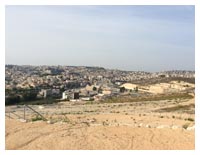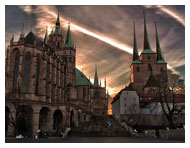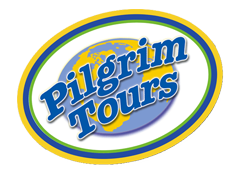

Click on the tabs for more information
Price Per person double occupancy
| Dates | Land Only No Transfers |
Early Reservation Discount (6 Mo. Adv.) |
|---|---|---|
| 2026 | ||
|
June 2-17 October 13-28 |
$5,499 | $5,379 |
|
Single Supplement: Year-round 2026: $1,650 |
||
|
*PASSOVER ITINERARY - FOLLOW THE PATH OF HUMILIATION, PAIN AND SUFFERING. DEPARTURE INCLUDES A SEDER MEAL, DAVID'S TOWER SOUND & LIGHT SHOW, AND OTHER TEACHING TIMES TO MAKE THIS A WONDERFUL TIME OF CELEBRATION, WORSHIP AND BIBLICAL INSIGHT. INFORMATION LINKS: Seder Meal, Passover |
||
Price Includes: 14 nights lodging with breakfast and dinner daily, full-time English-speaking tour guide, city step on guides (as needed), all touring and entrances as listed in itinerary, transportation by deluxe motorcoach.
Please Note: Israel & Germany gratuities will be paid in advance ($210 per person will be added to your final invoice for gratuities to be paid to drivers, guides, cruise and hotel staff).
Not Included: Airfare, lunches, transfers (unless airfare is purchased through Pilgrim Tours), tips to tour guide, city guides, driver and hotel staff (will be collected at final payment), optional travel insurance. Israel gratuities will be paid in advance ($125 per person will be added to your final invoice for gratuities to be paid to driver, guide, and hotel staff while in Israel).
Airport transfers are included only when airfare is purchased from Pilgrim Tours. Taxi service is available for those purchasing their airfare elsewhere.
Please Note: Travelers from Visa Exempt countries (which include the United States, Canada, UK, Australia, and many others) visiting and/or traveling through Israel must apply for an ETA (Electronic Travel Authorization) online at Israel ETA-IL Application (https://israel-entry.piba.gov.il/). Once approved, an ETA confirmation will be emailed to you. There is no need to print this confirmation; simply save it on your phone. The cost of the ETA permit is 25 shekels (approximately 7 USD), and it permits stays of up to 90 days. The permit remains valid for up to two years or until your passport expires, whichever occurs first. Failure to meet these entry requirements may result in loss of tour participation and associated penalties.
*Customers traveling to Israel that do not provide their full passport information will incur an additional fee of $160 per person to cover the Israel VAT (value-add tax) on their final invoice.
Deposit Required: A $300 per person US Dollar deposit (which includes a $100 non-refundable service fee) is required to secure a reservation.
Day 1: Departure
Today we embark on our Journey to the Holy Land. Prepare yourself for a life-changing experience. Get some rest on the flight…tomorrow you will be walking where Jesus walked!
Day 2: Arrive Israel

Arrive in Israel and travel northward to our hotel for one night in the coastal area near Tel Aviv. The remainder of the day is free to walk along the Mediterranean, relax, and have dinner. The time is right for a personal devotional with the sunset over the “Great Sea.” Meet your Israeli guide, enjoy a time of prayer of thanks for safety and the special blessings ahead, a prayer for the people of the "Promised Land," and a good night’s rest.
Day 3: Caesarea, Megiddo, & Nazareth

After breakfast, we travel by private motor coach along the coast of the Mediterranean Sea to Caesarea, where Gentiles first heard the Good News from Peter and were baptized. We’ll see the Roman Amphitheatre, hippodrome, a film on history and the remains of this famous port city, an aqueduct, and then journey through the Mt. Carmel range, where Elijah challenged King Ahab and the prophets of Baal. Next we travel through the Jezreel Valley to Megiddo, the Armageddon battlefield, where archaeologists have unearthed 20 levels of civilization. We drive through the area of Cana and Nazareth, the boyhood home of Jesus, where we visit the Nazareth Village, a wonderful recreation of Biblical times with costumed guides. We will have dinner and overnight lodging for the next three nights along the Sea of Galilee.
Day 4: Dan, Caesarea Philippi, Jesus Boat, Sea of Galilee Boat Ride, Magdala

Following breakfast, our morning travels take us to two valuable northern sites. Dan is where the children of Israel fell to the depths of alternative sacrifice and Caesarea Philippi, the site of Peter’s confession and pagan worship. We pass the possible site of the multiplication of loaves and fishes in Bethsaida and the Mount of the Beatitudes. Returning to Galilee for a St. Peter’s fish lunch (other selections available), we then visit the ancient fisherman boat followed by a relaxing cruise on the Sea of Galilee. A brief scripture reading and devotional on board brings to life the experiences of Jesus and the fishermen disciples. We conclude our day with a visit to Magdala, hometown of Mary Magdalene. The recent excavation of the first century synagogue and well-preserved village makes Magdala one of the most interesting Biblical sites in Israel.
Day 5: Capernaum, Corazin, Mt. Arbel, Jordan River Baptism Site

Today we visit the Biblical towns of Capernaum and Corazin. Capernaum is located along the Sea of Galilee and was the hometown of Peter. It is likely where Jesus and the disciples lived during much of His ministry while in Galilee. Next, we visit Corazin which offers another example of a Jewish synagogue and a replica of the “Seat of Moses” which was carved out of the local basalt block and from which the scribes and Pharisees would have read the Torah. We enjoy a bird’s eye view of the Galilee region atop Mt. Arbel. Mt. Arbel could likely be the location that Jesus would get away from the crowds to take time in prayer with His heavenly Father. Here our guide will point out the various towns listed in scripture during the time of Jesus. We conclude our day with an opportunity to be baptized at the Jordan River Baptismal Site.
Day 6: Beit Shean, Bethany Beyond Jordan, Abraham's Tent, Mt. of Olives & Garden of Gethsemane

We travel southward this morning to Beit-Shean/Scythopolis, the most magnificent archeological site in Israel, located at the strategic juncture of the Jezreel and Jordan valleys. Like Jericho, it has been almost continuously occupied throughout history. After defeating Saul and his sons on Mt. Gilboa, the Philistines hanged their bodies on the walls of Beit-Shean. During the time of Jesus, Scythopolis was one of the chief cities of the Decapolis - a league of ten cities sharing Greek culture and government. Following the fertile Jordan Valley southward, your guide will point out the agricultural restoration of the “Land of Milk and Honey” and Israel’s intricate irrigation development. We pass ancient Jericho and view from a distance this city famed as the oldest in the world. To the east of Jericho along the Jordan River Valley (Queser El Yehud) is the Israeli side of Bethany Beyond the Jordan. In this area Jesus was baptized by John the Baptist; Elijah and Elisha crossed the Jordan; and the children of Israel, led by Joshua, entered the Promised Land. This afternoon we will take part in the Genesis Land/Dinner in Abraham's Tent, where we enjoy a trip back in time to relive life in the time of the Patriarchs, complete with costume, dramatic presentation, camel ride and authentic food. Arriving in Jerusalem we’ll enjoy a beautiful view of the Old City atop the Mt. of Olives and then the Garden of Gethsemane. How many have wished to be whisked back in time to get a glimpse of our Lord or hear His voice if only for a moment? To walk between the ancient olive trees, read the scriptures of Jesus' prayer and take time for personal reflection is important here. We will have dinner and overnight lodging for the next three nights in Jerusalem.
Day 7: Masada, Ein Gedi, Dead Sea Scrolls, Dead Sea Swim

Our day begins with a cable car ride to the mountain top fortress of Masada. Here our guide will treat us to the history of the famous zealot stand. Afterwards we proceed to Ein Gedi, "Spring of the Goat," an oasis on the western shore of the Dead Sea. Because of its warm climate and abundant supply of water, the site developed a reputation for its fragrant plants and date palm groves. This is where King David hid from Saul and where God defeated the enemies of the Israelites by praise and worship led by King Jehoshaphat. Next, we visit the Qumran Caves where the Dead Sea Scrolls were discovered. This afternoon we have an opportunity to enjoy a relaxing float in the Dead Sea.
Day 8: Jesus’ Steps, Western Walls, Southern Steps, Way of Suffering, Garden Tomb

Today we walk where Jesus walked, beginning the day with a visit to the Wailing Wall and then the fascinating Rabbinical Tunnels leading us through the Second Temple era. The tunnel and exhibit give a clear understanding of the amazing construction of the Temple Mount, giant stones, water supply and Roman street where our Lord was led to judgment. Before exiting the tunnel, we see the immense cornerstone rejected by the builders. Next, we visit the Southern Wall Excavations. This southern side of The Temple was the main entrance for the common folk, whereas the Priests and Levites had their own entrance from the higher eastern side. Parts of the giant stairs, which led to the Temple Mount from the courtyard have been unearthed along with the purification pools. From here Jesus entered the Temple Mount and drove out the vendors and money exchangers who were exploiting the people. It is also likely that this is the place where Peter stood and preached and where thousands were saved and baptized on the Day of Pentecost. This afternoon we move on to the Judgment Hall of Pilate, hear of those who conspired against Him and are reminded of His brutal beating and humiliation. From here we will also be able to see the Pool of Bethesda, Stephen's Gate, and St. Anne’s Church. While walking along the Via Dolorosa, we are reminded of His way of suffering along with a visit to the Church of the Holy Sepulcher. Our guide will explain the differing opinions on the route where Christ was led. (The actual place of crucifixion and burial is a very interesting study!) The climax of the day is the area of Golgotha (place of the skull) and the Garden Tomb, where we celebrate the resurrection with communion and a time of praise.
Day 9: Travel to Munich

This morning we fly from Tel Aviv to Munich. Arrival into the Munich airport. Enjoy a tour of the city. Our sightseeing begins with a driving tour of Munich including outside views of the Olympic Stadium, Pinakotheken art museums, Royal Palace (Residenz), National Theater, and the world famous Hofbräuhaus. Take a walking tour of the Marienplatz which lies at the heart of the Alstadt in the city center. This lively, attractive square houses the Gothic New Town hall (Neue Rathaus) with its famous Glockenspiel and the Old Town Hall. We transfer to the Munich hotel for our dinner and overnight.
Day 10: Neuschwanstein Castle, Oberammergau

This morning we head south to explore the Bavarian countryside with our first stop at the fairy-tale castle, Neuschwanstein Castle. We take a guided tour of Ludwig II's most luxurious former residence where the interior styles range from Byzantine to Romanesque to Gothic. This castle, built between 1869 and 1886, has a most impressive view with the Alpsee Lake below and the Alps towering above. We continue to the Pilgrimage Church of Wies to visit this oval Rococo style church which is a UNESCO World Heritage site. From here we continue to the delightful village of Oberammergau which has been the home of the Passion Play performance since 1680. We return to Munich later this afternoon and enjoy our dinner and overnight.
Day 11: Augsburg, Rothenberg
This morning we travel north to the ancient city of Augsburg, the place where the Augsburg Confession was presented. Our morning drive will allow for time to rehearse this important document and digest the tremendous meaning it has as the basis for much of our doctrine today. It was also here in 1518 at St. Anne's Church that Luther met the papal legate, Cardinal Cajetan, who demanded that Luther submit to the pope. Augsburg was also the site of another Imperial Diet (1530). This afternoon we travel the panoramic "Romantic Road" and visit the best preserved medieval town in all of Europe, Rothenberg ob der Tauber. We see the quaint Rathaus (town hall) with its impressive tower and have free time for coffee and shopping in the many delightful shops. You may choose to visit on your own the Kriminal-museum, housing all manner of Medieval instruments of torture. Overnight in Rothenberg.
Day 12: Heidelberg, Worms, Mainz

This morning we travel to one of the most charming cities in all of the world - Heidelberg, ancient capital of the Palatinate and home of Germany's oldest university. But most importantly, it was a stronghold of German Reformed Protestants beginning in 1560. One of the great confessional statements of the Reformation, the Heidelberg Catechism was produced here in 1563. We tour Heidelberg Castle, a most impressive historic landmark of Germany that stands majestically overlooking the Neckar River. The structure, now largely in ruins, preserves numerous examples of Medieval, Renaissance, and Baroque German architecture. Our next stop is in Worms. It was here, during the Imperial Diet in 1521, that Martin Luther challenged the entire Roman Catholic establishment by his refusal to recant the great doctrines of Protestantism. It was also here that William Tyndale completed the printing of his English version of the New Testament in 1525 which he had begun in Cologne. After seeing St. Peter's Church and the symbolic Luther memorial near the town square, we transfer to Mainz. In Mainz we view the Gutenberg Monument and then visit the Gutenberg Museum to learn about printing from the moveable metal type and see a Gutenberg Bible. We overnight in Frankfurt.
Day 13: Eisenach & Wartburg Castle

This morning we depart Mainz and drive to Eisenach, the birthplace of Johann Sebastian Bach and the childhood home of Martin Luther. Luther recognized that his failure to recant at the Diet of Worms (April, 1521) had put him in very serious danger. For this reason, after his defiant confession of faith before the emperor, he was rushed away back to Wittenberg by coach. On the way back, he was overtaken by a group of Frederick the Wise’s guards disguised as highwaymen. They escorted the Reformer back to Wartburg Castle where he would remain for the next ten months. Wartburg Castle was a hunting castle that belonged to the ducal family of Saxony. To the present day, it lies in the Thuringian forest in north-central Germany. It was here at the formidable Wartburg Castle that Luther, under "house arrest", translated the New Testament into the German language in 1523. We visit the castle and see where Luther spent his time. We end out day in Erfurt where we enjoy our dinner and overnight.
Day 14: Erfurt, Eisleben

This morning we spend time in Erfurt where Luther attended the university. A highlight will be the Augustinian Monastery where he spent his early years as a monk. Leaving Erfurt we visit Eisleben which is noted among the most significant in Luther's history; he was born here in 1483 and died here in 1546 and old manuscripts indicate that he felt a special affinity to Eisleben. We will see the house of his birth and death, St. Andrews Church where he preached his last sermon, the Luther Monument, and St. Anne's Church with the famous Biblical scenes hewn in stone and many other sites. We continue to Wittenberg for dinner and overnight.
Day 15: Wittenberg, Berlin

We continue the Reformation Trail today with a visit to Wittenberg where Martin Luther lived and taught for 36 years. You will see the Castle Church door where Luther posted his 95 Theses, giving birth to the Reformation and the Town Church where he preached. We see the Luther House which is the greatest museum of Reformation History in the world. This afternoon we transfer to Berlin for a short tour of the Berlin Wall, Brandenburg Gate, and Checkpoint Charlie. Overnight in Berlin.
Day 16: Departure
We transfer to the airport for our flight home.
*The tour itinerary is subject to change or be slightly modified in order to best meet the interests of the group.
*The tour itinerary is subject to change or be slightly modified in order to best meet the interests of the group.

